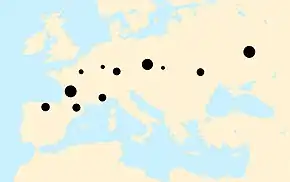Gravettian
The Gravettian was an archaeological industry of the European Upper Paleolithic that succeeded the Aurignacian circa 33,000 years BP.[1][4] It is archaeologically the last European culture many consider unified,[5] and had mostly disappeared by c. 22,000 BP, close to the Last Glacial Maximum, although some elements lasted until c. 17,000 BP.[2] In Spain and France, it was succeeded by the Solutrean, and developed into or continued as the Epigravettian in Italy, the Balkans, Ukraine[6] and Russia.[7]
Left: Female face, ivory carving, Dolní Věstonice, Gravettian, circa 26,000 BP. Right: Venus of Willendorf, circa 25,000 BP. Middle: Engraving on a mammoth tusk. Bottom: Main Gravettian sites | |
| Geographical range | Europe |
|---|---|
| Period | Upper Paleolithic |
| Dates | 33,000[1] to 21,000 BP[lower-alpha 1] |
| Type site | La Gravette |
| Major sites | Dordogne |
| Characteristics | Venus figurines |
| Preceded by | Aurignacian |
| Followed by | Solutrean, Epigravettian |
| Defined by | Dorothy Garrod, 1938[3] |
The Gravettian culture is known for Venus figurines, which were typically carved from either ivory or limestone. The culture was first identified at the site of La Gravette in the southwestern French department of Dordogne.[8] In terms of population, the Gravettian is associated with the Vestonice cluster (while the older Aurignacian cultural complex is associated with the human remains of Goyet Q116-1).[9]
Gravettian culture

The Gravettians were hunter-gatherers who lived in a bitterly cold period of European prehistory, and the Gravettian lifestyle was shaped by the climate. Pleniglacial environmental changes forced them to adapt. West and Central Europe were extremely cold during this period. Archaeologists usually describe two regional variants: the western Gravettian, known mainly from cave sites in France, Spain and Britain, and the eastern Gravettian in Central Europe and Russia. The eastern Gravettians, which include the Pavlovian culture, were specialized mammoth hunters,[8] whose remains are usually found not in caves but in open air sites.
Gravettian culture thrived on their ability to hunt animals. They utilized a variety of tools and hunting strategies. Compared to theorized hunting techniques of Neanderthals and earlier human groups, Gravettian hunting culture appears much more mobile and complex. They lived in caves or semi-subterranean or rounded dwellings which were typically arranged in small "villages". Gravettians are thought to have been innovative in the development of tools such as blunted-back knives, tanged arrowheads and boomerangs.[8] Other innovations include the use of woven nets and oil lamps made of stone.[10] Blades and bladelets were used to make decorations and bone tools from animal remains.
Gravettian culture extends across a large geographic region, as far as Estremadura in Portugal.[11] but is relatively homogeneous until about 27,000 BP.[12] They developed burial rites,[10] which included simple, purpose-built offerings and/or personal ornaments owned by the deceased, placed within the grave or tomb.[13] Surviving Gravettian art includes numerous cave paintings and small, portable Venus figurines made from clay or ivory, as well as jewelry objects. The fertility deities mostly date from the early period; there are over 100 known surviving examples. They conform to a very specific physical type, with large breasts, broad hips and prominent posteriors. The statuettes tend to lack facial details, and their limbs are often broken off.[12]
During the post glacial period, evidence of the culture begins to disappear from northern Europe but was continued in areas around the Mediterranean.[12]
The Mal'ta Culture (c. 24,000 BP) in Siberia is often considered as belonging to the Gravettian,[14] due to its similar characteristics, particularly its Venus figurines, but any hypothetical connection would have to be cultural and not genetic: a 2016 genomic study showed that the Mal'ta people have no genetic connections with the people of the European Gravettian culture (the Vestonice Cluster).[15]
Diet
Animals were a primary food source for humans of the Gravettian period.[16] Since Europe was extremely cold during this period, they preferred food sources high in energy and fat content. Testing comparisons among various human remains reveal that populations at higher latitudes placed greater dietary emphasis on meat. A defining trait distinguishing Gravettian people was their ease of mobility compared to their Neanderthal counterparts. Modern humans developed the technology and social organization that enabled them to migrate with their food source whereas Neanderthals were not adept at travelling, even with relatively sedentary herds.[17]
With their ability to move with the herds, Gravettian diets incorporated a huge variety of animal prey. The main factors were the animal's age and size. For example, first year deer offered hides most suitable for clothing, while fourth year deer contained far more meat.[18] Gravettian diet included larger animals such as mammoths, hyenas, wolves, and reindeer killed with stone or bone tools, as well as hares and foxes captured with nets.[19] This time period is classified by the strong emphasis on meat consumption because agriculture had not been fully introduced nor utilized. In addition, the climate was not favorable to stable crop cultivation.[16]
Coastal Gravettians were able to avail of marine protein. From remains found in Italy and Wales, carbon dating reveals that 20–30% of Gravettian diets of coastal peoples consisted of sea animals.[20][21] Populations of lower latitudes relied more on shellfish and fish while higher latitudes' diets consisted of seals.[21]
Physical type
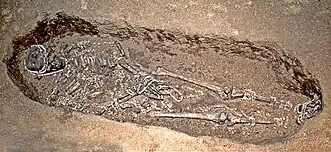
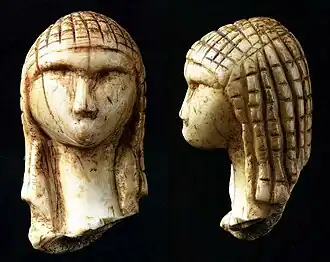
Physical remains of people of the Gravettian have revealed that they were tall and relatively slender people. The male height of the Gravettian culture ranged between 179 and 188 centimetres (5 ft 10 in and 6 ft 2 in) tall with an average of 183.5 centimetres (6 ft 0.2 in), which is exceptionally tall not only for that period of prehistory, but for all periods of history.[22][23]
They were fairly slender and normally weighed between 67–73 kilograms (148–161 lb), although they would likely have had a higher ratio of lean muscle mass compared to body fat in comparison to modern humans as a result of a very physically active and demanding lifestyle. The females of the Gravettian were much shorter, standing 158 centimetres (5 ft 2 in) on average, with an average weight of 54 kilograms (119 lb). Examinations of Gravettian skulls reveal that high cheekbones were common among them.[24][25][26]
Hunting
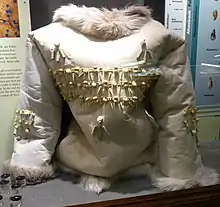
Clubs, stones and sticks were the primary hunting tools during the Upper Paleolithic period. Bone, antler and ivory points have all been found at sites in France; but proper stone arrowheads and throwing spears did not appear until the Solutrean period (~20,000 Before Present). Due to the primitive tools, many animals were hunted at close range.[27] The typical artefact of Gravettian industry, once considered diagnostic, is the small pointed blade with a straight blunt back. They are today known as the Gravette point,[28] and were used to hunt big game. Gravettians used nets to hunt small game, and are credited with inventing the bow and arrow.[8]
Gravettian settlers tended towards the valleys that pooled migrating prey.[27] Examples found through discoveries in Gr. La Gala, a site in Southern Italy, show a strategic settlement based in a small valley.[29] As the settlers became more aware of the migration patterns of animals like red deer, they learned that prey herd in valleys, thereby allowing the hunters to avoid travelling long distances for food. Specifically in Gr. La Gala, the glacial topography forced the deer to pass through the areas in the valley occupied by humans.[29] Additional evidence of strategically positioned settlements include sites like Klithi in Greece, also placed to intercept migrating prey.[18]
Discoveries in the Czech Republic suggest that nets were used to capture large numbers of smaller prey, thus offering a quick and consistent food supply and thus an alternative to the feast/famine pattern of large game hunters. Evidence comes in the form of 4 mm (0.16 in) thick rope preserved on clay imprints.[19] Research suggests that although no larger net imprints have been discovered, there would be little reason for them not to be made as no further knowledge would be required for their creation.[19] The weaving of nets was likely a communal task, relying on the work of both women and children.[19]
Use of animal remains
Decorations and tools

The Gravettian era landscape is most closely related to the landscape of present-day Moravia. Pavlov I in southern Moravia is the most complete and complex Gravettian site to date, and a perfect model for a general understanding of Gravettian culture. In many instances, animal remains indicate both decorative and utilitarian purposes. In the case of, for example, Arctic foxes, incisors and canines were used for decoration, while their humeri and radii bones were used as tools. Similarly, the skeletons of some red foxes contain decorative incisors and canines as well as ulnas used for awls and barbs.[30]
Some animal bones were only used to create tools. Due to their shape, the ribs, fibulas, and metapodia of horses were good for awl and barb creation. In addition, the ribs were also implemented to create different types of smoothers for pelt preparation. The shapes of hare bones are also unique, and as a result, the ulnas were commonly used as awls and barbs. Reindeer antlers, ulnas, ribs, tibias and teeth were utilised in addition to a rare documented case of a phalanx.[30] Mammoth remnants are among the most common bone remnants of the culture, while long bones and molars are also documented. Some mammoth bones were used for decorative purposes. Wolf remains were often used for tool production and decoration.[30]
Genetics
Fu et al. (2016) examined the remains of fourteen Gravettians. The eight males included three samples of Y-chromosomal haplogroup CT, one of I, one IJK, one BT, one C1a2, and one sample of F. Of the fourteen samples of mtDNA, there were thirteen samples of U and one sample of M. The majority of the sample of U belonged to the U5 and U2.[31] Teschler et al. (2020) examined the remains of one adult male and two twin boys from a Gravettian site in Austria. All belonged to haplogroup Y-Haplogroup I.[32] and all had the same mtDNA, U5. According to Scorrano et al. (2022), "the genome of an early European individual from Kostenki 14, dated to around 37,000 years ago, demonstrated that the ancestral European gene pool was already established by that time.”[33]
Gallery
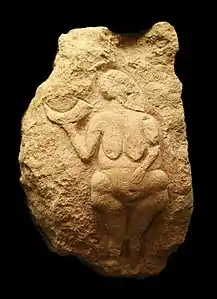 Venus-de-Laussel
Venus-de-Laussel Male figurine, mammoth ivory, Anthropos, Brno
Male figurine, mammoth ivory, Anthropos, Brno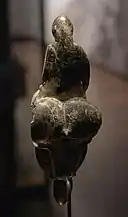

 Female figurines, Gravettian, Anthropos, Brno
Female figurines, Gravettian, Anthropos, Brno Upper Paleolithic art, relief of mammoth, Anthropos, Brno
Upper Paleolithic art, relief of mammoth, Anthropos, Brno Various Gravettian statuettes
Various Gravettian statuettes Shaman equipment, Brno, Gravettian
Shaman equipment, Brno, Gravettian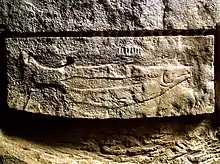 Fish in Abri du Poisson Cave
Fish in Abri du Poisson Cave Engraving on a mammoth tusk, map
Engraving on a mammoth tusk, map Engraving on a mammoth tusk, map
Engraving on a mammoth tusk, map Gravettian necklace
Gravettian necklace.jpg.webp) Gravettian engraving (Venus of Předmostí)
Gravettian engraving (Venus of Předmostí) Venus figurine from Kostenki
Venus figurine from Kostenki.jpg.webp) Replica of the Venus of Lespugue
Replica of the Venus of Lespugue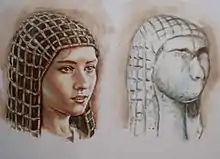 Reconstruction of the Lady of Brassempouy by Libor Balák
Reconstruction of the Lady of Brassempouy by Libor Balák
See also
| The Paleolithic |
|---|
| ↑ Pliocene (before Homo) |
| ↓ Mesolithic |
- Art of the Upper Paleolithic
- Aurignacian culture
- Earth's Children series
- Epigravettian
- Haplogroup I-M170
- Last Glacial Maximum
- List of Stone Age art
- Perigordian
- Solutrean
- Upper Paleolithic
- Venus figurines
- Bayac, Dordogne commune closest to the type-site of La Gravette
Note
- The transition to the Epigravettian is not well-defined, and the Gravettian may be extended down to 17,000 years ago with the most inclusive definition, based on anything that may be considered Gravettian (burials, venus statues, lithics)[2]
References
- Jacobi, R.M.; Higham, T.F.G.; Haesaerts, P.; Jadin, I.; Basell, L.S. (2015). "Radiocarbon chronology for the Early Gravettian of northern Europe: New AMS determinations for Maisières-Canal, Belgium". Antiquity. 84 (323): 26–40. doi:10.1017/S0003598X00099749. S2CID 163089681.
- Pesesse, Damien (2013). "Le Gravettien existe-t-il? Le prisme du système technique lithique" [Does the Gravettian exist? The prism of the lithic technical system]. In Marcel Otte (ed.). Les Gravettiens. Civilisations et cultures (in French). Paris: Éditions errance. pp. 66–104. ISBN 978-2877725095.
D'ailleurs selon les auteurs et les thèmes abordés, la définition et donc les contours du Gravettien variant, parfois considérablement. Tantôt certains ensembles de la plaine russe seront intégrés sur la base des témoignages funéraires, tantôt les statuettes féminines serviront d'argument pour annexer les rives du lac Baïkal à cette supra-entité. De même, le Gravettien débuterait vers 31,000 BP ou 27,000 BP selon les régions pour finir parfois à 22,000 BP, parfois à 17,000 BP. Ce ne sont pas là de menues différences. [Besides, depending on the authors and the subjects at hand, the definition and therefore the borders of the Gravettian vary, sometimes considerably. Sometimes, certain assemblages of the Russian plains are integrated on the basis of funerary customs, other times feminine statuettes are used to annex the shores of Lake Baikal to this supra-entity. Likewise, the Gravettian would start around 31,000 or 27,000 BP depending on the region and finish sometimes at 22,000 BP, sometimes at 17,000 BP. These are not small differences.]
- Garrod, D. A. E. (2014). "The Upper Palaeolithic in the Light of Recent Discovery". Proceedings of the Prehistoric Society. 4 (1): 1–26. doi:10.1017/S0079497X00021113. S2CID 4041425.
- Pike, A. W. G.; Hoffmann, D. L.; Garcia-Diez, M.; Pettitt, P. B.; Alcolea, J.; De Balbin, R.; Gonzalez-Sainz, C.; De Las Heras, C.; Lasheras, J. A.; Montes, R.; Zilhao, J. (2012). "U-Series Dating of Paleolithic Art in 11 Caves in Spain". Science. 336 (6087): 1409–13. Bibcode:2012Sci...336.1409P. doi:10.1126/science.1219957. PMID 22700921. S2CID 7807664.
- Noiret, Pierre (2013). "De quoi Gravettien est-il le nom?" [Gravettian is the name of what?]. In Marcel Otte (ed.). Les Gravettiens. Civilisations et cultures (in French). Paris: Éditions errance. pp. 28–64. ISBN 978-2877725095.
- Marquer, L.; Lebreton, V.; Otto, T.; Valladas, H.; Haesaerts, P.; Messager, E.; Nuzhnyi, D.; Péan, S. (2012). "Charcoal scarcity in Epigravettian settlements with mammoth bone dwellings: The taphonomic evidence from Mezhyrich (Ukraine)". Journal of Archaeological Science. 39 (1): 109–20. Bibcode:2012JArSc..39..109M. doi:10.1016/j.jas.2011.09.008.
- Germonpré, Mietje; Sablin, Mikhail; Khlopachev, Gennady Adolfovich; Grigorieva, Galina Vasilievna (2008). "Possible evidence of mammoth hunting during the Epigravettian at Yudinovo, Russian Plain". Journal of Anthropological Archaeology. 27 (4): 475–92. doi:10.1016/j.jaa.2008.07.003.
- Kipfer, Barbara Ann. "Encyclopedic Dictionary of Archaeology". Kluwer Academic/Plenum Publishers, 2000. P. 216. ISBN 978-0-3064-6158-3
- Fu 2016: "GoyetQ116-1 is chronologically associated with the Aurignacian cultural complex. Thus, the subsequent spread of the Vestonice Cluster, which is associated with the Gravettian cultural complex, shows that the spread of the latter culture was mediated at least in part by population movements."
- Bains, Gurnek. "Cultural DNA: The Psychology of Globalization". John Wiley & Sons, 2015. p. 199. ISBN 978-1-1189-2891-2
- Marks, Anthony E., Bicho, Nuno, Zilhao, Joao, Ferring, C. R. (1994). "Upper Pleistocene Prehistory in Portuguese Estremadura: Results of Preliminary Research". Journal of Field Archaeology. 21 (1): 53–68. doi:10.2307/530244. JSTOR 530244.
{{cite journal}}: CS1 maint: multiple names: authors list (link) - De Laet, S.J. "History of Humanity: Prehistory and the beginnings of civilization". United Nations Educational Scientific and Cultura, 1994. p. 212. ISBN 978-9-2310-2810-6
- Renfrew, Colin. "Death Rituals, Social Order and the Archaeology of Immortality in the Ancient World: 'Death Shall Have No Dominion'". Cambridge University Press, 2018. p. 58. ISBN 978-1-1070-8273-1
- Nowell, April (30 June 2021). Growing Up in the Ice Age: Fossil and Archaeological Evidence of the Lived Lives of Plio-Pleistocene Children. Oxbow Books. p. 62. ISBN 978-1-78925-297-2.
The Gravettian site of Mal'ta...
- Fu, Qiaomei; Posth, Cosimo; et al. (May 2, 2016). "The genetic history of Ice Age Europe". Nature. 504 (7606): 200–5. Bibcode:2016Natur.534..200F. doi:10.1038/nature17993. hdl:10211.3/198594. PMC 4943878. PMID 27135931.
Thus, while individuals assigned to the Gravettian cultural complex in Europe are associated with the Vestonice Cluster, there is no genetic connection between them and the Mal'ta individual in Siberia despite the fact that Venus figurines are associated with both. This suggests that if this similarity is not a coincidence, it reflects diffusion of ideas rather than movements of people.
- Schulting, R.J., Trinkaus, E., Higham, T., Hedges, R., Richards, M. & Cardy, B. (1997). "A mid-upper Palaeolithic human humerus from eel point, south Wales, UK". Journal of Human Evolution. 48 (5): 493–505. doi:10.1016/j.jhevol.2005.02.001. PMID 15857652.
{{cite journal}}: CS1 maint: multiple names: authors list (link) - Holden, C. (2004). "Neandertals and Climate". Science. 303 (5659): 759. doi:10.1126/science.303.5659.759a. S2CID 220102720.
- Bogucki, P. (1999). The Origins of Human Society. Oxford: Blackwell Publications inc. p. 95.
- Pringle, H (1997). "Ice Age Communities May Be Earliest Known Net Hunters". Science. 277 (5330): 1203–1204. doi:10.1126/science.277.5330.1203. S2CID 128873468.
- Pettitt, P.B.; et al. (2003). "The Gravettian burial known as the Prince ("Il Principe"): new evidence for his age and diet" (PDF). Antiquity. 77 (295): 15. doi:10.1017/S0003598X00061305. S2CID 38461013.
- Jacobi, R., Richards, M., Cook, J., Pettitt, P.B. & Stringer, C.B. (2005). "Isotope evidence for the intensive use of marine foods by Late Upper Palaeolithic humans". Journal of Human Evolution. Max Planck Institute for Evolutionary Anthropology. 49 (3): 390–394. doi:10.1016/j.jhevol.2005.05.002. PMID 15975629.
{{cite journal}}: CS1 maint: multiple names: authors list (link) - Holt, Brigitte M.; Formicola, Vincenzo (2008). "Hunters of the Ice Age: The biology of Upper Paleolithic people". American Journal of Physical Anthropology. Suppl 47: 70–99. doi:10.1002/ajpa.20950. ISSN 1096-8644. PMID 19003886.
- Hermanussen, Michael (July 2003). "Stature of early Europeans". Hormones. 2 (3): 175–178. doi:10.14310/horm.2002.1199. ISSN 1109-3099. PMID 17003019.
- Trinkaus, Erik; Svoboda, Jiřı́; West, Dixie L; Sládek, Vladimı́r; Hillson, Simon W; Drozdová, Eva; Fišáková, Miriam (2000-12-01). "Human Remains from the Moravian Gravettian: Morphology and Taphonomy of Isolated Elements from the Dolnı́ Věstonice II Site". Journal of Archaeological Science. 27 (12): 1115–1132. Bibcode:2000JArSc..27.1115T. doi:10.1006/jasc.1999.0501. ISSN 0305-4403.
- Holt, Brigitte M.; Formicola, Vincenzo (2008). "Hunters of the Ice Age: The biology of Upper Paleolithic people". American Journal of Physical Anthropology. 137 (S47): 70–99. doi:10.1002/ajpa.20950. ISSN 1096-8644. PMID 19003886.
- Wilczyński, Jarosław (January 2015). "The Gravettian and Epigravettian settlement of Poland". Institute of Archeology of the CAS, Brno & Masaryk University. 2: 45 – via Researchgate.
- Straus, L.G. (1993). "Upper Paleolithic Hunting Tactics and Weapons in Western Europe". Archeological Papers of the American Anthropological Association. University of New Mexico. 4 (1): 83–93. doi:10.1525/ap3a.1993.4.1.83.
- Ehrich, Robert W.; Pleslová-Štiková, Emilie. "Aurignacian Lithic Economy: Ecological Perspectives from Southwestern France". Academia, 1968. pp. 37–41
- Mussi, M. (2001). Earliest Italy: An Overview of the Italian Paleolithic and Mesolithic. Kluwer Academic/Plenum Publishers. pp. 250–252. ISBN 9780306464638.
- Nývltová-Fisáková, M. (2005). "Animal bones selected for tools and decorations". In J. Svoboda (ed.). Pavlov I southeast: A window into the gravettian lifestyles. Brno, Czech Republic: Academy of the Sciences of the Czech Republic, Institute of Archaeology. pp. 247–251.
- Fu 2016.
- Teschler-Nicola, Maria; Fernandes, Daniel; Händel, Marc; Einwögerer, Thomas; Simon, Ulrich; Neugebauer-Maresch, Christine; Tangl, Stefan; Heimel, Patrick; Dobsak, Toni; Retzmann, Anika; Prohaska, Thomas (2020-11-06). "Ancient DNA reveals monozygotic newborn twins from the Upper Palaeolithic". Communications Biology. 3 (1): 650. doi:10.1038/s42003-020-01372-8. ISSN 2399-3642. PMC 7648643. PMID 33159107.
- Scorano, G. (18 November 2022). "Genomic ancestry, diet and microbiomes of Upper Palaeolithic hunter-gatherers from San Teodoro cave". Communications Biology. 5 (1): 1262. doi:10.1038/s42003-022-04190-2. PMC 9674856. PMID 36400919. S2CID 245021783.
Sources
- Fu, Qiaomei (May 2, 2016). "The genetic history of Ice Age Europe". Nature. Nature Research. 534 (7606): 200–205. Bibcode:2016Natur.534..200F. doi:10.1038/nature17993. hdl:10211.3/198594. PMC 4943878. PMID 27135931.
External links
- Picture Gallery of the Paleolithic (reconstructional palaeoethnology), Libor Balák at the Czech Academy of Sciences, the Institute of Archaeology in Brno, The Center for Paleolithic and Paleoethnological Research
- Cave sites in France
- 20,000-year-old Gravettian stone pendant found in Piatra Neamţ, Romania
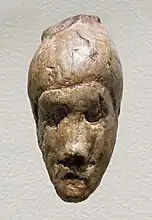

.jpg.webp)
